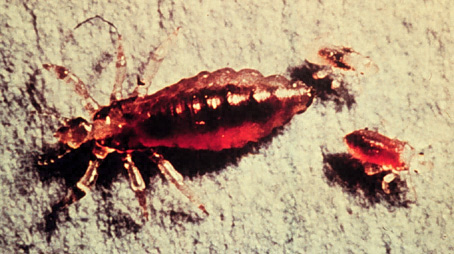This page contains head lice pictures. After the photos we have extensive information about lice, including the symptoms, how you get it, prevention, and the most effective treatment option.
If you need additional pictures for any reason, please contact us and we will be happy to send you more.
Photos Of Lice
Click on any of the photos of lice for treatment information.


Head lice photo as adult, nymph and nit.

Photos of lice nits(eggs).


Lice Information
Hopefully the head lice pictures were very helpful.
Head lice, also called pediculus humanus capitis, is the most common type of lice. Other types of lice include body lice and pubic lice. Lice are also known as louse.
Head lice are parasitic insects that are found on people’s heads. Having head lice is extremely common. It is estimated that 6-12 million people in the USA get head lice each year.
Adult female lice lay eggs, called nits. These nits are firmly attached to the base of the hair shaft, closest to the scalp. The nits are often confused with dandruff. After a week or so, the nit hatches into a baby louse called a nymph. Nymph’s look like adult louses, except are smaller. They become an adult in 10 days, and as an adult live for about 30 days. To live, lice must feed on blood. If the louse falls off a person and cannot feed, it will die within 2 days.
Who Can Get Lice
Anyone can get lice. You are at greatest risk of getting hair lice if you come into close contact with someone who already has head lice. Head to head contact is the most common way to get lice, however, you can also get it from contact with an infected persons clothing (such as hat, coat, scarves, hair ribbon) or other personal items (such as a brush, comb or a towel). Head lice cannot jump or fly.
Young children, ages 3-10, and their families are most often infested. Girls get lice more often then boys, and women more often than men. A person’s degree of cleanliness or personal hygiene has nothing to do with getting head lice. Hair lice are much less common in African Americans, due to hair type.
Head Lice Symptoms
While, some people have no symptoms, most people will have some or all of these symptoms:
- Frequent feeling of something moving in the hair.
- Nits that look like whitish shells are found attached to the base of hair strands near the scalp. (They can be seen in the head lice pictures)
- Scalp itching that is caused by an allergic reaction to the lice bites.
- Irritability.
- Red sores that can become infected if repeatedly scratched.
Where Are Head Lice Found
Hair lice are found on the scalp, behind the ears and near the hairline at the neck. They are rarely found in eyelashes, eyebrows or on the body. They are difficult to see, and can change color to match the host hairs.
Lice have six legs. At the end of each leg is a hook like claw that they use to hold on to hair with. (These can be seen in the photos of lice)
Now that you have seen the head lice pictures and gone over general head lice information, its important to discuss treatment.
Head Lice Treatment
There is a very safe and effective treatment that we have been recommending for several years now. It is all-natural, and kills all lice and their eggs in just one application. It stops the itching, and starts to work in just 7 minutes. The manufacturer is so confident in the product that they give an unconditional money back guarantee. For more information on the best lice treatment, follow this link to the Fairy Tales Lice Removal Kit.
In addition to lice treatment, all household members should be checked for lice and nits. Also, the infected persons bed linens and clothing should be washed in hot water. Non-washable items like stuffed animals should be put in plastic bags for 2 weeks, and then opened outside. Combs and brushes should be soaked in alcohol or hot water for 5 minutes. The water should be at least 131°F or 55°C.
If you have any questions about the head lice pictures, please contact us. If you have photos of lice and want our opinion on them, please let us know.
More than Head Lice Pictures on our Hair Lice page
Healthy Skin Guide Home Page
